Spinal Reflex Recovery after Dorsal Rhizotomy and Repair with Platelet-Rich Plasma (PRP) Gel Combined with Bioengineered Human Embryonic Stem Cells (hESCs)
- PMID: 33178285
- PMCID: PMC7647752
- DOI: 10.1155/2020/8834360
Spinal Reflex Recovery after Dorsal Rhizotomy and Repair with Platelet-Rich Plasma (PRP) Gel Combined with Bioengineered Human Embryonic Stem Cells (hESCs)
Abstract
Dorsal root rhizotomy (DRZ) is currently considered an untreatable injury, resulting in the loss of sensitive function and usually leading to neuropathic pain. In this context, we recently proposed a new surgical approach to treat DRZ that uses platelet-rich plasma (PRP) gel to restore the spinal reflex. Success was correlated with the reentry of primary afferents into the spinal cord. Here, aiming to enhance previous results, cell therapy with bioengineered human embryonic stem cells (hESCs) to overexpress fibroblast growth factor 2 (FGF2) was combined with PRP. For these experiments, adult female rats were submitted to a unilateral rhizotomy of the lumbar spinal dorsal roots, which was followed by root repair with PRP gel with or without bioengineered hESCs. One week after DRZ, the spinal cords were processed to evaluate changes in the glial response (GFAP and Iba-1) and excitatory synaptic circuits (VGLUT1) by immunofluorescence. Eight weeks postsurgery, the lumbar intumescences were processed for analysis of the repaired microenvironment by transmission electron microscopy. Spinal reflex recovery was evaluated by the electronic Von Frey method for eight weeks. The transcript levels for human FGF2 were over 37-fold higher in the induced hESCs than in the noninduced and the wildtype counterparts. Altogether, the results indicate that the combination of hESCs with PRP gel promoted substantial and prominent axonal regeneration processes after DRZ. Thus, the repair of dorsal roots, if done appropriately, may be considered an approach to regain sensory-motor function after dorsal root axotomy.
Copyright © 2020 Mateus Vidigal de Castro et al.
Conflict of interest statement
The authors declare that there is no conflict of interests regarding the publication of this paper.
Figures

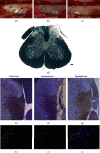

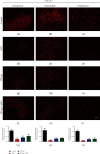
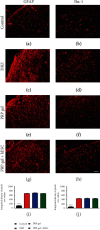
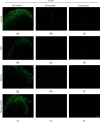
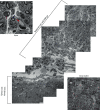
Similar articles
-
Reflex arc recovery after spinal cord dorsal root repair with platelet rich plasma (PRP).Brain Res Bull. 2019 Oct;152:212-224. doi: 10.1016/j.brainresbull.2019.07.024. Epub 2019 Jul 24. Brain Res Bull. 2019. PMID: 31351157
-
Synaptic plasticity and sensory-motor improvement following fibrin sealant dorsal root reimplantation and mononuclear cell therapy.Front Neuroanat. 2014 Sep 9;8:96. doi: 10.3389/fnana.2014.00096. eCollection 2014. Front Neuroanat. 2014. PMID: 25249946 Free PMC article.
-
Functional repair after dorsal root rhizotomy using nerve conduits and neurotrophic molecules.Eur J Neurosci. 2004 Sep;20(5):1211-8. doi: 10.1111/j.1460-9568.2004.03595.x. Eur J Neurosci. 2004. PMID: 15341593
-
Ensheathing glia transplants promote dorsal root regeneration and spinal reflex restitution after multiple lumbar rhizotomy.Ann Neurol. 1999 Feb;45(2):207-15. doi: 10.1002/1531-8249(199902)45:2<207::aid-ana11>3.0.co;2-k. Ann Neurol. 1999. PMID: 9989623
-
Endogenous neurotrophins and plasticity following spinal deafferentation.Exp Neurol. 2012 May;235(1):70-7. doi: 10.1016/j.expneurol.2010.12.021. Epub 2010 Dec 30. Exp Neurol. 2012. PMID: 21195072 Review.
Cited by
-
Embedding Bioprinting of Low Viscous, Photopolymerizable Blood-Based Bioinks in a Crystal Self-Healing Transparent Supporting Bath.Small Methods. 2025 Jan;9(1):e2400857. doi: 10.1002/smtd.202400857. Epub 2024 Jul 6. Small Methods. 2025. PMID: 38970553 Free PMC article.
-
Evolving trends in stem cell therapy: an emerging and promising approach against various diseases.Int J Surg. 2024 Nov 1;110(11):6862-6868. doi: 10.1097/JS9.0000000000001948. Int J Surg. 2024. PMID: 39699861 Free PMC article. No abstract available.
-
Selection Criteria of Cord Blood Units for Platelet Gel Production: Proposed Directions from Hellenic Cord Blood Bank. Comment on Mallis et al. Short Term Results of Fibrin Gel Obtained from Cord Blood Units: A Preliminary in Vitro Study. Bioengineering 2019, 6, 66.Bioengineering (Basel). 2021 Apr 27;8(5):53. doi: 10.3390/bioengineering8050053. Bioengineering (Basel). 2021. PMID: 33925496 Free PMC article.
-
Dorsal Root Injury-A Model for Exploring Pathophysiology and Therapeutic Strategies in Spinal Cord Injury.Cells. 2021 Aug 25;10(9):2185. doi: 10.3390/cells10092185. Cells. 2021. PMID: 34571835 Free PMC article. Review.
-
Cell Therapy for Neurological Disorders: The Perspective of Promising Cells.Biology (Basel). 2021 Nov 6;10(11):1142. doi: 10.3390/biology10111142. Biology (Basel). 2021. PMID: 34827135 Free PMC article. Review.
References
-
- Wu L., Wu J., Chang H. H., Havton L. A. Selective plasticity of primary afferent innervation to the dorsal horn and autonomic nuclei following lumbosacral ventral root avulsion and reimplantation in long term studies. Experimental Neurology. 2012;233(2):758–766. doi: 10.1016/j.expneurol.2011.11.034. - DOI - PubMed
LinkOut - more resources
Full Text Sources
Research Materials
Miscellaneous

